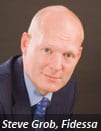Two reports on dark trading levels suggest the European equity market was approaching a landmark in the first quarter of 2013.
"We're starting to see some areas of the market where the level of dark trading is getting towards 5%. We would expect to see a further boost that market participants can't afford to ignore," Steve Grob, group strategy director at technology vendor Fidessa, said.
At 5% the broker community get interested, Grob explains, which gives an extra boost towards 10% that would get the attention of the buy-side. Fidessa's second quarterly 'European Dark Trading Analysis' found that total lit and dark consideration increased by 14% in Q1 2013 - with dark going up by 28% within that combined percentage. "Dark levels are still modest, but they're consistently going up," Grob said.
Using the Fidessa Fragmentation Index database (all dark MTFs owned/operated by venues and broker-dealers; excluding broker crossing networks, or BCNs), the analysis also found that average trade size was steadily coming down in the dark. Regulation is a contributing factor here, according to Grob. "In the US, average trade size is much smaller in dark venues than in Europe, and it's smaller again in Canada. That reflects the degree of regulatory concern over whether dark trading is taking liquidity away from lit markets." Grob acknowledges the ambiguity that order sizes reported by venues typically result from an algo 'chopping up' the original order.
The latest European edition of Rosenblatt Securities' 'Let There Be Light' monthly dark-liquidity tracker found that European dark pool market share had declined from a February all-time high of 5.13% to 4.97% of consolidated pan-European value traded in March 2013. Rosenblatt Securities' universe comprises 18 venues. However, citing issues with non-reporting by BCNs, the New York-headquartered broker notes, "It's possible that total dark-pool activity in Europe in March could have been as much as 6.2%-6.4% of consolidated turnover.
For Rosenblatt, European market share trends in March were "muddled" by the 1 March introduction of Italy's financial transaction tax. But there were strong and unambiguous gains for some venues: strong rises in month-on-month ADVT were reported by Instinet BlockMatch (+24.96%); ITG Posit (+17.2%); Liquidnet (+14.7%); UBS MTF (+36.3%). Two of these were also singled out by Fidessa. Invited to give his view on which dark pools institutional investors seem to favour, Grob said: "One that seems to be ahead is UBS MTF. It covers the complete range of European stocks, and it's comparatively cheap. Another to mention is Instinet BlockMatch, which has obviously got a boost from its merger with Nomura NX."
In its US version of 'Let There Be Light', Rosenblatt estimated a 14.67% share of consolidated US equity volume in March, based on an 18-pool reporting universe plus estimates for other venues, down from a January record high. Dark trading in Canada stood at 2.02% in March, having been close to 2% since new regulations came into force in October 2012. The US tracker offers a detailed analysis of the "ongoing war of words and lobbying … over dark, off-exchange trading". No US venues reported month-on-month gains in ADV in March, although Barclays LX, Deutsche Bank Super X and UBS ATS were cited as having gained market share over the past two years.
Both Fidessa and Rosenblatt Securities found regulation to be significant in determining the scale of dark-pool activity. Discussing the likely impact of MiFID II in Europe, Fidessa's Grob said, "Markets are more complicated than perhaps politicians believe. They should be wary of unintended consequences."
